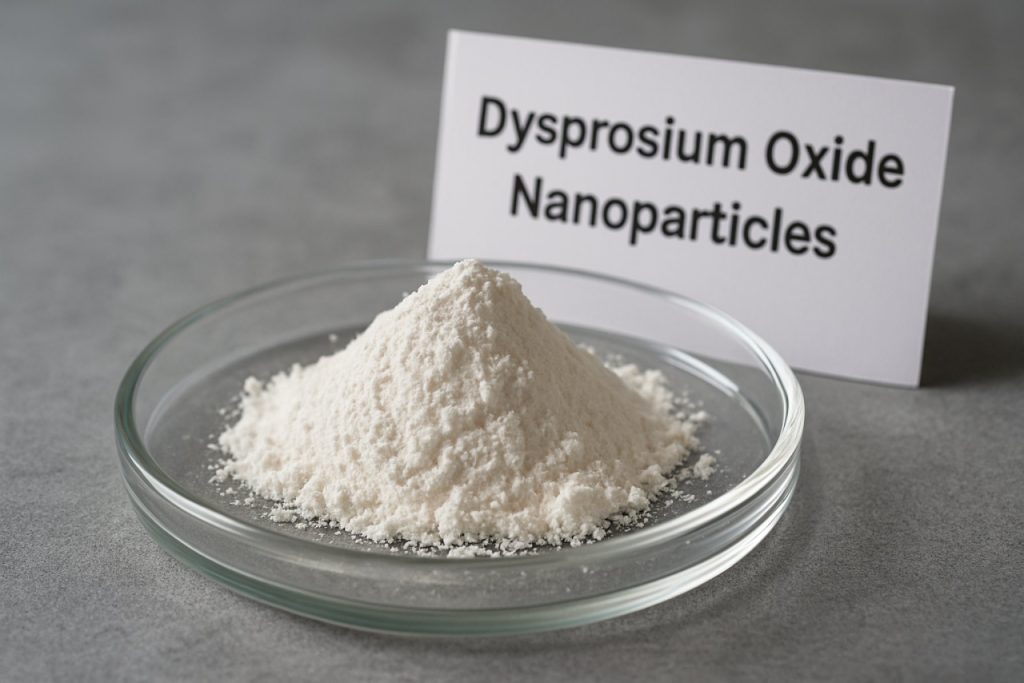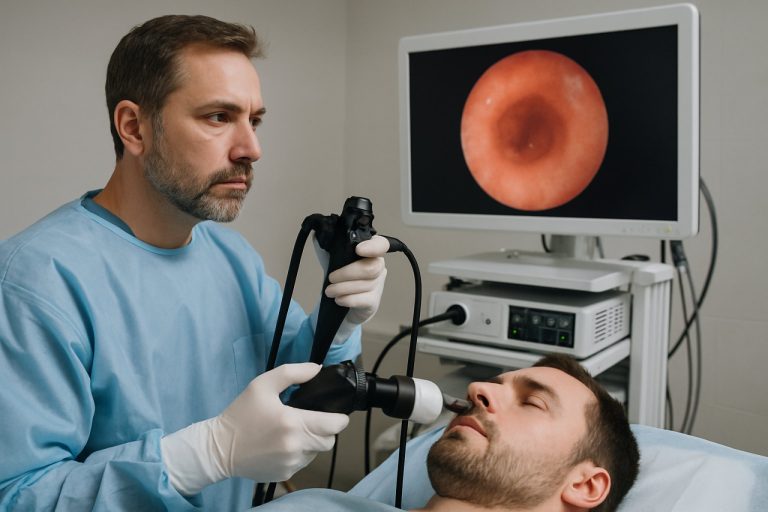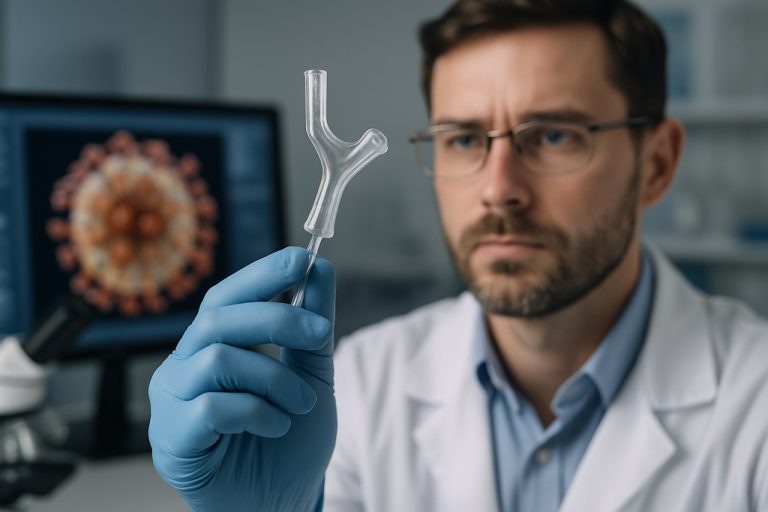
Table of Contents
- Executive Summary: Key Trends in Dysprosium Oxide Nanoparticle Synthesis (2025–2030)
- Market Forecast: Growth Projections and Demand Drivers
- Cutting-Edge Synthesis Technologies and Emerging Methods
- Leading Manufacturers and Global Supply Chain Overview
- Strategic Applications: Electronics, Magnets, and Quantum Devices
- Regulatory Landscape and Industry Standards
- Competitive Analysis: Innovation Pipelines and Patenting Activity
- Sustainability, Environmental Impact, and Recycling Initiatives
- Investment Hotspots and Strategic Partnerships
- Future Outlook: Disruptive Trends and Opportunities Through 2030
- Sources & References
Executive Summary: Key Trends in Dysprosium Oxide Nanoparticle Synthesis (2025–2030)
Dysprosium oxide nanoparticle synthesis is entering a phase of rapid innovation and market expansion as industries capitalize on their unique magnetic, optical, and catalytic properties. As of 2025, the synthesis landscape is shaped by a dual focus: scalable, cost-effective production and environmental sustainability. Leading manufacturers are optimizing sol-gel, hydrothermal, and combustion methods to achieve uniform particle size, high purity, and enhanced dispersibility, which are critical for electronics, data storage, and emerging quantum technologies.
Recent investments in automation and process control have enabled higher production yields and reproducibility. For instance, American Elements and NanoAmor have expanded their facilities to produce dysprosium oxide nanoparticles at commercial scales, emphasizing tight quality control and custom synthesis options. These companies are responding to demand from sectors such as high-performance magnets and next-generation semiconductors.
Environmental and regulatory considerations are increasingly shaping synthesis strategies. Companies such as Alfa Aesar are adopting greener synthesis routes, minimizing hazardous solvent use and optimizing energy consumption. New aqueous-phase and microwave-assisted synthesis techniques are being developed to reduce waste and improve safety profiles.
Global supply chain resilience is also a key trend. With dysprosium supply concentrated in a few regions, suppliers are investing in recycling and secondary sourcing initiatives. For instance, LANXESS is exploring rare earth recycling as a supplementary feedstock for nanoparticle production. Parallel efforts in process digitalization, including real-time monitoring and advanced analytics, are expected to boost efficiency and traceability throughout the value chain.
Looking ahead to 2030, the sector is expected to benefit from cross-industry collaborations, particularly with automotive and renewable energy companies seeking advanced magnetic materials for electric vehicles and wind turbines. Research partnerships between manufacturers and academic institutions are accelerating the development of tailored nanoparticles with novel properties, positioning the industry for continued growth and diversification.
In summary, from 2025 onward, dysprosium oxide nanoparticle synthesis is characterized by a concerted shift toward sustainable, scalable, and high-precision production, underpinned by technological innovation and evolving end-market requirements.
Market Forecast: Growth Projections and Demand Drivers
The market for dysprosium oxide nanoparticle synthesis is poised for significant expansion in 2025 and the following years, driven by rapid advancements in nanotechnology, energy storage, and magnetics. As global industries seek higher performance materials for electronics and renewable energy, dysprosium oxide nanoparticles—valued for their magnetic, optical, and catalytic properties—are attracting increased R&D and commercial interest.
Recent statements from leading rare earth producers and nanomaterial suppliers underline robust forward-looking demand. LANXESS has highlighted dysprosium’s essential role in next-generation permanent magnets for electric vehicles and wind turbines, both sectors expected to see strong growth through 2025. These magnets require high-purity dysprosium oxide nanoparticles to achieve optimal thermal stability and coercivity. Similarly, American Elements reports an uptick in orders for custom-synthesized dysprosium oxide nanoparticles from academic and industrial customers, citing their use in solid-state lasers and quantum computing prototypes.
The growing deployment of advanced energy systems is a key demand driver. According to Rio Tinto, global sales of electric vehicles and renewable energy installations are set to accelerate in 2025, correlating with increased dysprosium consumption. The synthesis of nanoparticles with tightly controlled size and morphology is crucial for these applications, as it directly impacts the performance of end-products. Companies such as Nanoshel are investing in scalable production methods, including sol-gel and hydrothermal techniques, to meet the anticipated surge in demand from energy and electronics manufacturers.
From a geographic perspective, Asia-Pacific remains the dominant region for both production and consumption. China’s state-owned enterprises—including Chinalco—are expanding capacity and refining nanoparticle synthesis processes to secure their supply chains for high-technology exports. Meanwhile, North American and European manufacturers are actively seeking partnerships and joint ventures with established producers to ensure reliable access to dysprosium oxide nanoparticles.
Looking ahead, the market outlook for dysprosium oxide nanoparticle synthesis remains highly positive, shaped by ongoing innovation in materials science and the strategic push for electrification and digitalization across multiple sectors. As end-use applications diversify and scale, industry participants are expected to prioritize sustainable sourcing and advanced synthesis technologies, reinforcing the upward trajectory through 2025 and beyond.
Cutting-Edge Synthesis Technologies and Emerging Methods
Dysprosium oxide nanoparticles are pivotal in advanced magnetic, electronic, and optical applications. The synthesis of these nanoparticles has seen significant innovation, particularly as demand surges for next-generation permanent magnets, quantum computing components, and biomedical imaging agents. As of 2025, the industry is witnessing a transition from conventional high-temperature solid-state and co-precipitation methods to more controlled, scalable, and environmentally benign synthesis routes.
Hydrothermal and solvothermal techniques remain at the forefront, enabling precise control over particle size and morphology with relatively low energy input. These methods are being actively optimized by industry leaders to achieve uniform, monodispersed dysprosium oxide nanoparticles. For instance, American Elements reports ongoing improvements in hydrothermal processing parameters to enhance purity and surface characteristics, crucial for electronic and magnetic device fabrication.
Simultaneously, solution-based synthesis—such as the sol-gel and microemulsion techniques—is gaining traction for its scalability and ability to yield nanoparticles with tailored surface properties. Companies like NanoAmor are commercializing sol-gel-derived dysprosium oxide nanoparticles, highlighting advancements in solvent systems and surfactant selection to minimize agglomeration and control crystallinity.
A notable emerging trend is the deployment of green synthesis approaches utilizing biotemplates or plant extracts, minimizing toxic reagents and reducing environmental impact. Initial pilot-scale demonstrations by specialty chemical suppliers indicate that biosynthesis could become commercially viable within the next few years, aligning with global sustainability objectives and increasingly stringent regulatory standards.
Microwave-assisted and ultrasonic synthesis technologies are also under active development. These methods offer rapid reaction kinetics and enhanced uniformity, with equipment manufacturers and material producers collaborating to develop continuous-flow systems for industrial-scale production. For example, Sigma-Aldrich (MilliporeSigma) supports research and supply of both conventional and novel dysprosium oxide nanoparticle formats, reflecting the broader market’s readiness to adopt alternative synthesis strategies.
Over the next few years, the focus will likely intensify on integrating automation, real-time process monitoring, and AI-driven optimization to further enhance reproducibility and scale-up efficiency. As the sector evolves, close cooperation between nanoparticle producers, equipment manufacturers, and end-users will be critical in pushing synthesis technologies toward higher throughput, reduced waste, and superior product quality.
Leading Manufacturers and Global Supply Chain Overview
As of 2025, the synthesis and global supply of dysprosium oxide nanoparticles are shaped by a small number of leading manufacturers specializing in rare earth materials, as well as the logistical complexities inherent to the rare earth element (REE) supply chain. Dysprosium, prized for its magnetic and optical properties, is a critical component in various advanced technologies, including high-performance magnets, lasers, and biomedical applications. This has driven sustained interest in the scalable and precise synthesis of dysprosium oxide nanoparticles.
The majority of global dysprosium oxide production originates from a few key regions, notably China, which continues to dominate the rare earth sector through vertically integrated operations. Companies such as Aluminum Corporation of China (CHINALCO) and Baotou Steel Rare-Earth play pivotal roles in the extraction, refinement, and downstream processing of dysprosium compounds. These organizations have expanded their capabilities to include nanomaterial synthesis, leveraging advanced hydrothermal and solvothermal methods to control nanoparticle morphology and purity.
Outside of China, global players are actively investing in dysprosium oxide nanoparticle production to diversify supply and reduce geopolitical risk. LANXESS, a specialty chemicals company based in Germany, has increased its focus on rare earth oxides for advanced material applications, including the development of nanoparticles with controlled size and surface chemistry. Similarly, Solvay, headquartered in Belgium, continues to adapt its rare earth processing technologies, supporting the European supply chain for high-purity dysprosium oxide nanoparticles.
The supply chain for dysprosium oxide nanoparticles remains sensitive to fluctuations in REE mining, environmental regulations, and export policies, particularly in China. In response, initiatives in North America and Australia are accelerating. Lynas Rare Earths, operating out of Australia and Malaysia, has made strategic investments in the separation and refinement of heavy rare earths, including dysprosium, with an eye toward supporting nanoparticle synthesis for magnet and defense industries. These efforts are expected to intensify over the next few years, as demand for dysprosium in green technologies and electronics grows.
Looking forward, the global supply chain for dysprosium oxide nanoparticles is likely to be characterized by incremental diversification, increased adoption of environmentally friendly synthesis routes, and closer collaboration between upstream mining companies and downstream nanomaterial manufacturers. Strategic partnerships and government-backed projects in regions outside of China are anticipated to play a critical role in ensuring stable and sustainable supply as technological applications continue to expand.
Strategic Applications: Electronics, Magnets, and Quantum Devices
Dysprosium oxide (Dy2O3) nanoparticles have emerged as critical materials in strategic high-tech sectors, notably electronics, magnetic devices, and quantum technologies. As of 2025, advancements in synthesis methods are directly influencing their deployment in these applications. Nanoparticle synthesis techniques—such as hydrothermal, sol-gel, and thermal decomposition methods—have been refined to provide superior control over particle size, morphology, and surface chemistry, parameters vital for tailored performance in electronic and magnetic components.
In the electronics sector, dysprosium oxide nanoparticles are being increasingly integrated into capacitor dielectrics and advanced semiconductor devices, where their high dielectric constant and stability offer significant performance benefits. Several leading materials manufacturers, including American Elements and NanoAmor, have scaled up production of high-purity Dy2O3 nanopowders, emphasizing strict control of particle uniformity and purity to meet the stringent requirements of the electronics industry.
Dysprosium’s unique magnetic properties make its oxide form indispensable in the fabrication of high-performance permanent magnets, particularly in neodymium-iron-boron (NdFeB) magnets where dysprosium enhances coercivity and thermal stability. Manufacturers such as METALL RARE EARTH LIMITED supply dysprosium oxide nanoparticles that are incorporated into sintered magnet alloys for use in electric vehicle (EV) motors, wind turbines, and miniaturized actuators. The demand for nanoparticle-doped magnets is expected to grow as the global EV and renewable energy markets expand, driving further optimization of nanoparticle synthesis for scalability and cost efficiency.
In quantum devices, Dy2O3 nanoparticles are being explored for applications in quantum information storage and quantum sensing. Their strong magnetic anisotropy and paramagnetic behavior at the nanoscale offer advantages for next-generation spintronic and quantum memory devices. Leading suppliers like US Research Nanomaterials, Inc. provide custom-synthesized dysprosium oxide nanoparticles tailored for research in these cutting-edge fields.
Looking forward, innovation in synthesis—such as green chemistry approaches and scalable bottom-up fabrication—will likely lower costs and improve environmental sustainability. The next several years are expected to see continued collaboration between material suppliers and end-use sectors to further refine nanoparticle properties, ensuring reliable integration into advanced electronic, magnetic, and quantum technologies.
Regulatory Landscape and Industry Standards
The regulatory landscape for dysprosium oxide nanoparticle synthesis is evolving rapidly as both demand and applications expand across high-tech industries. In 2025, regulatory oversight is largely shaped by international frameworks governing nanomaterials, with particular attention to workplace safety, environmental impact, and material traceability. Organizations such as the International Organization for Standardization (ISO) and the ASTM International are at the forefront, updating and refining standards specifically relevant to rare earth nanomaterial synthesis, purity, and characterization.
ISO’s Technical Committee 229 continues to issue and revise standards, such as ISO/TR 18196:2016, which provides guidance on the physicochemical characterization of manufactured nano-objects, a category that includes dysprosium oxide nanoparticles. In 2025, further updates are anticipated to address size distribution, surface chemistry, and agglomeration metrics in the context of rare earth materials. Similarly, ASTM International’s Committee E56 is developing new protocols for measuring nanoparticle dispersion and contamination controls, aiming to harmonize testing procedures across manufacturers globally.
On the industry side, major producers like American Elements and NanoAmor publicly adhere to standards such as ISO 9001 for quality management systems and provide detailed material safety data sheets (MSDS) for their dysprosium oxide nanomaterials. These documents outline compliance with regional chemical regulations—REACH in the European Union and TSCA in the United States—ensuring that synthesized nanoparticles meet both domestic and international safety requirements.
Environmental and occupational safety guidelines continue to be informed by research into nanoparticle toxicity and lifecycle management. The Occupational Safety and Health Administration (OSHA) in the U.S. and the European Chemicals Agency (ECHA) are monitoring workplace exposure and environmental release, recommending best practices for handling, storage, and disposal of dysprosium oxide nanoparticles. In response, manufacturers are investing in closed-system synthesis and advanced filtration to minimize emissions and protect workers.
Looking forward, the regulatory focus is expected to intensify on full supply chain transparency, lifecycle assessment, and the establishment of globally recognized certification for nanomaterial synthesis processes. This will likely drive further collaborations between regulatory bodies and industry leaders to ensure responsible innovation and market access for dysprosium oxide nanoparticles in the coming years.
Competitive Analysis: Innovation Pipelines and Patenting Activity
The competitive landscape for dysprosium oxide nanoparticle synthesis in 2025 is characterized by a surge in innovation pipelines and a notable increase in patenting activity, reflecting the strategic importance of rare earth nanomaterials to sectors such as electronics, magnetics, and advanced energy devices. Key industry players, notably those with strong roots in rare earth extraction and advanced materials engineering, are advancing proprietary synthesis techniques to secure supply chains and differentiate their offerings.
Companies such as American Elements, a leading global supplier of engineered materials, have expanded their research and production capabilities for high-purity dysprosium oxide nanoparticles. Their recent announcements highlight proprietary hydrothermal and sol-gel methods that offer scalable synthesis with precise control over particle size and morphology—critical for applications in high-performance magnets and luminescent materials. Similarly, NanoAmor is investing in innovation to enhance the uniformity and dispersibility of dysprosium oxide nanoparticles, targeting emerging demand from the optoelectronics and biomedical imaging sectors.
Patent filings in 2024 and into 2025 reveal a growing focus on green synthesis pathways and surface modification strategies for dysprosium oxide nanoparticles. The Chemours Company, for instance, has disclosed new patent applications surrounding eco-friendly routes for rare earth oxide nanoparticle production, emphasizing reduced energy consumption and minimal hazardous byproducts. These efforts align with global sustainability goals and anticipate regulatory shifts in the advanced materials supply chain.
A review of the European Patent Office and United States Patent and Trademark Office databases shows that leading manufacturers—such as Hayden Corporation and LANXESS—are increasingly patenting surface engineering technologies. These innovations aim to improve the stability and functional integration of dysprosium oxide nanoparticles in composite materials, enhancing their value proposition for next-generation electronics and renewable energy storage.
Looking ahead, the competitive dynamics in this sector will likely intensify as government-backed research initiatives and industry partnerships accelerate the translation of laboratory-based synthesis methods to commercial-scale production. The ongoing convergence of material science, nanotechnology, and sustainability imperatives is expected to drive further patent activity and shape the innovation pipelines of established players and new entrants alike. As a result, intellectual property portfolios will remain central to securing competitive advantages in the dysprosium oxide nanoparticle domain through 2026 and beyond.
Sustainability, Environmental Impact, and Recycling Initiatives
The synthesis of dysprosium oxide nanoparticles (Dy2O3 NPs) is witnessing a pronounced shift toward sustainability and environmental responsibility as the industry enters 2025. This transition is largely motivated by the criticality of dysprosium as a rare earth element, environmental regulations, and growing end-user demand for greener nanomaterial production. Notably, manufacturers and research institutions are prioritizing process innovations that reduce energy consumption, minimize waste, and enable recycling of both precursor materials and nanostructured products.
Key players in rare earth materials, such as LANXESS and Solvay, have publicly outlined their intent to incorporate closed-loop water management and solvent-recycling systems within their rare earth oxide production lines, including those for dysprosium oxide. This approach reduces both the environmental footprint of synthesis and operating costs, as solvents and water can be reused in successive nanoparticle batches. Additionally, Metall Rare Earth Limited has introduced protocols for the recovery of dysprosium from spent magnets and electronic waste, enabling the use of recycled dysprosium precursors in nanoparticle synthesis.
On the academic front, collaborative projects with industry are focusing on greener synthesis routes, such as hydrothermal and solvothermal methods that employ non-toxic surfactants, reduce reaction temperatures, and use bio-based reducing agents. For example, the utilization of plant extracts as both stabilizing and reducing agents is being tested in pilot programs with support from manufacturers, aiming to lower the carbon footprint compared to conventional thermal decomposition or precipitation techniques.
In terms of regulatory outlook, organizations such as the International Maritime Organization (IMO) and United States Environmental Protection Agency (EPA) are expected to tighten restrictions on industrial effluents containing rare earths, driving further adoption of closed-loop and low-emission synthesis strategies. Additionally, industry consortia including the Rare Earth Industry Association are increasingly supporting recycling initiatives and establishing standards for traceability, safe handling, and lifecycle analysis of dysprosium-based nanomaterials.
In the near term, these trends are set to accelerate, with pilot recycling plants and sustainable synthesis demonstration projects moving to commercial scale by late 2025. The anticipated outcomes are reduced reliance on primary mining, improved resource efficiency, and a measurable reduction in the environmental impact associated with dysprosium oxide nanoparticle production.
Investment Hotspots and Strategic Partnerships
The synthesis of dysprosium oxide nanoparticles is rapidly emerging as a focal point for investment and collaboration, particularly as demand for advanced magnetic, optical, and electronic materials intensifies globally. In 2025, the sector is witnessing heightened interest from both established rare earth corporations and innovative nanotechnology firms, driven by the critical role dysprosium plays in high-performance magnets, quantum computing, and next-generation electronics.
Asia-Pacific remains the most dynamic region for investments, with Chinese enterprises such as Chinalco and Grirem Advanced Materials expanding their research and production facilities for rare earth oxides, including dysprosium-based nanomaterials. These companies are not only scaling up output but are also entering joint ventures with domestic universities and research institutes to optimize nanoparticle synthesis methods, focusing on efficiency and environmental sustainability.
In Europe, Solvay has signaled strategic intent by investing in its rare earth derivatives capacity, targeting tailored dysprosium oxide nanoparticle solutions for the electronics and clean energy sectors. Collaborative projects between Solvay and leading technical universities are anticipated to yield proprietary synthesis routes that reduce energy consumption and minimize hazardous by-products, aligning with the region’s green transition goals.
North America is also experiencing a strategic push, illustrated by Molycorp (now part of MP Materials) and LANXESS exploring supply chain agreements and technology licensing with startups specializing in nanoparticle engineering. These partnerships aim to secure access to high-purity dysprosium oxide nanoparticles for domestic manufacturing, especially for electric vehicle motors and defense applications.
Looking ahead to the next few years, the sector is expected to see further cross-border alliances. Companies are actively pursuing vertical integration strategies, securing sources of dysprosium ore and investing in in-house nanoparticle synthesis capabilities. Simultaneously, public-private partnerships are accelerating, with government-backed initiatives in the US, EU, and Japan providing funding and regulatory support for innovations in dysprosium oxide nanoparticle production.
Overall, 2025 marks a period of intensified investment and collaboration in dysprosium oxide nanoparticle synthesis, with industry leaders leveraging partnerships to enhance technical expertise, ensure secure supply, and meet the evolving requirements of advanced technology markets.
Future Outlook: Disruptive Trends and Opportunities Through 2030
The synthesis of dysprosium oxide (Dy2O3) nanoparticles is expected to experience transformative advancements through 2030, driven by increasing demand for high-performance materials in electronics, photonics, and energy applications. As of 2025, manufacturers and research organizations are scaling efforts to optimize synthetic routes that offer precise control over particle size, morphology, and purity, responding to requirements from sectors such as magnetics and advanced ceramics.
- Scalable Green Synthesis: Environmental considerations are catalyzing a shift toward greener synthesis methods. Companies focusing on rare earths, like LANXESS and Solvay, are exploring aqueous-phase and low-temperature processes that minimize hazardous by-products and energy consumption. These techniques are expected to enhance the sustainability of nanoparticle production while maintaining industrial scalability.
- Advanced Morphological Control: The next wave of research aims to refine hydrothermal, solvothermal, and microemulsion techniques, enabling tailored nanoparticle shapes and sizes for specific end-use applications. Companies such as Nanografi are actively developing proprietary protocols for uniform, monodisperse dysprosium oxide nanoparticles, positioning themselves to meet the stringent needs of quantum computing and high-density data storage.
- Integration into Smart Materials: By 2030, integration of Dy2O3 nanoparticles into multifunctional materials—such as magneto-optical devices and luminescent ceramics—is expected to accelerate. Suppliers like American Elements are expanding their product lines and working with device manufacturers to tailor nanoparticle properties for specific photonic and magneto-optical applications.
- Supply Chain Localization and Security: The rare earth supply chain remains vulnerable to geopolitical and environmental pressures. Major producers including Lynas Rare Earths are investing in regional processing facilities and vertical integration to secure feedstocks for nanoparticle production, ensuring reliable supply for high-tech industries in North America, Europe, and Asia.
Looking ahead, disruptive trends such as AI-guided synthesis optimization, in situ characterization techniques, and closed-loop recycling of dysprosium from end-of-life devices are poised to further reshape the landscape. With ongoing innovation from key industry players and strategic investments in sustainable production, the dysprosium oxide nanoparticle sector is set to play a critical role in enabling next-generation technologies through 2030.



